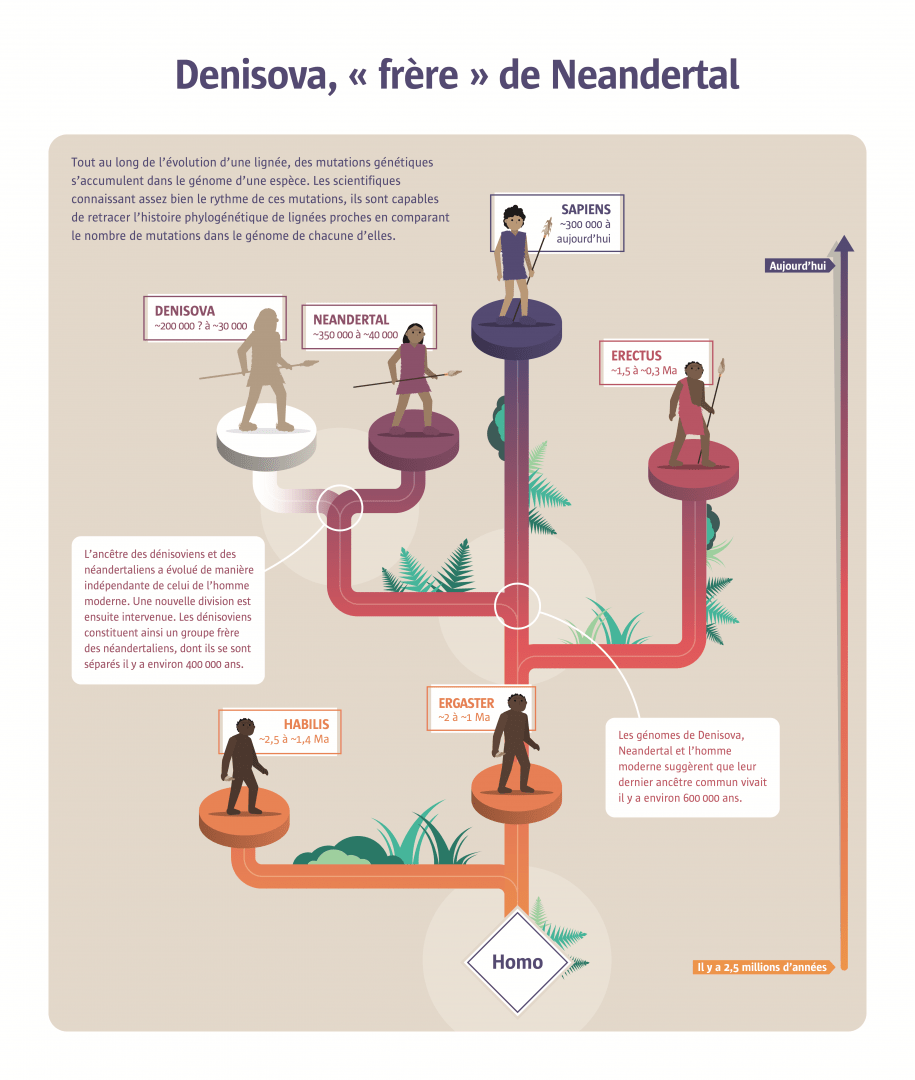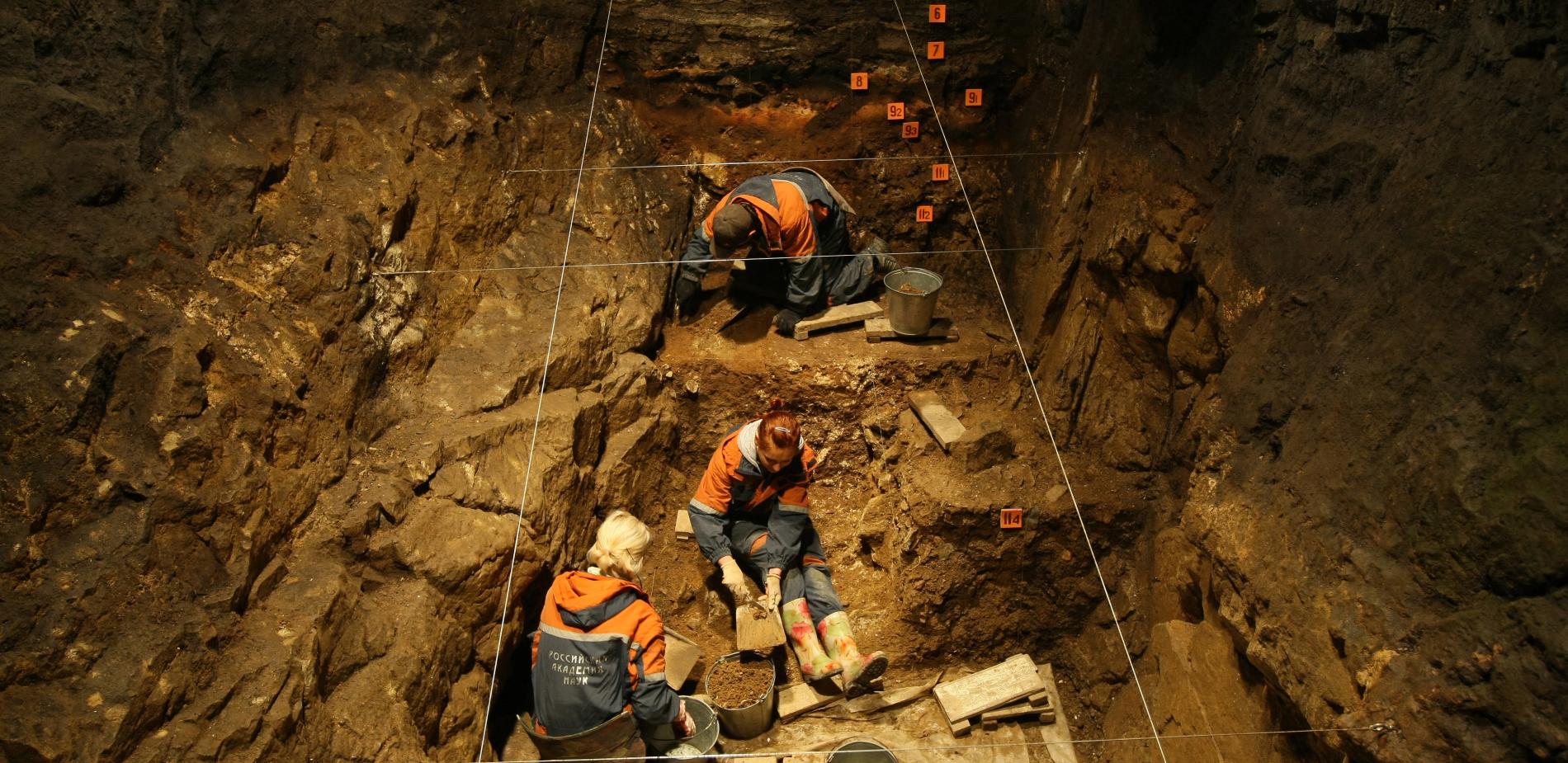
Denisovan hominins at the heart of a palaeogenetic revolution
The discovery of Denisovan hominins through DNA analysis reflects the increasingly important role of genetics in the study of our ancestors.
Investigation by Alexane Roupioz - Published on
Despite the recent discovery of new fossils attributed to Denisovan hominins, that ancient human species still has many secrets. Siblings of the Neanderthals, Denisovans were first identified in 2010 on the basis of some rare fossils. But it is essentially through the sequencing of their genome that we now know something of their history – their spread in Eurasia and their interbreeding with modern humans. Their DNA also offers insights into some aspects of their biology, social relationships and even culture, discoveries that would not have been possible without advances in palaeogenetics, now an essential tool for the study of human history.
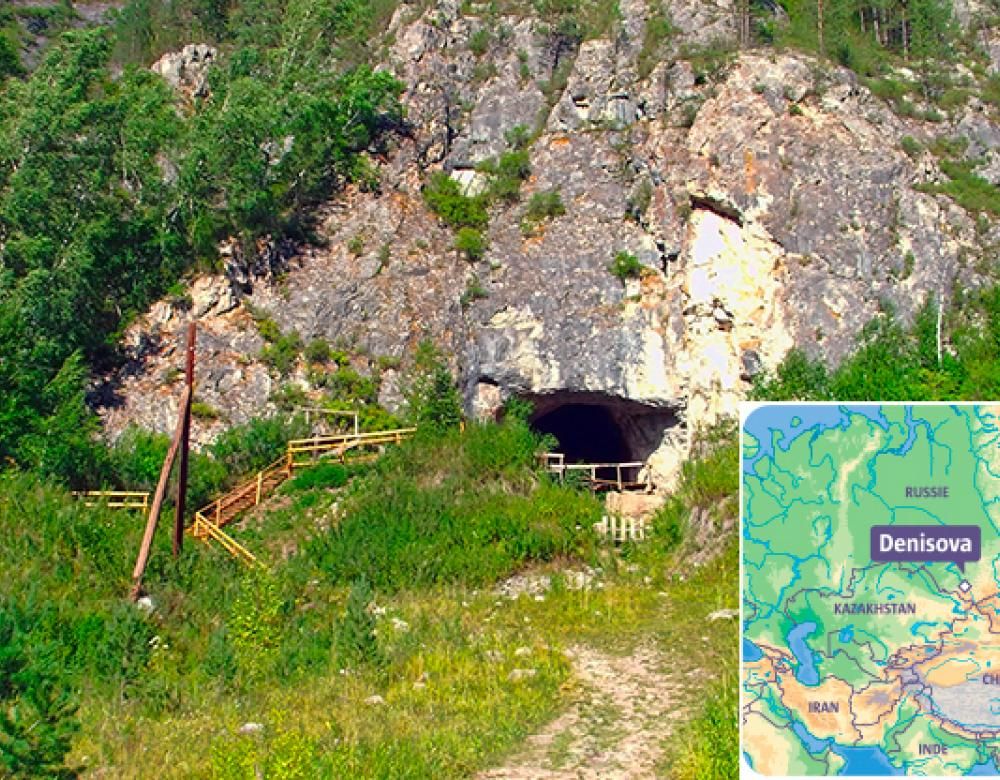
The Denisova cave, a treasure trove of DNA
Digs are still continuing today in the Denisova cave as researchers hunt for new traces of ancient DNA. Conditions on the site are good for the conservation of that precious compound, which holds the genetic heritage of species. The temperature is stable at about 0 °C and the biological, physical and chemical environments are favourable (humidity, acidity, and so on). The many bone fossils discovered in the cave—the oldest of which belonged to a Denisovan who lived sometime between 122,700 and 194,400 years ago—show that Neanderthal and Denisovan populations coexisted for thousands of years.
A hominin identified by their genome
For a long time, the study of our ancestors was based on the analysis of fossils and artefacts.
But now, with the Denisovans, palaeogenetics has taken over. It all began in 2010 with the discovery of a tiny fragment of a human phalanx in the Denisova cave in the Altai Mountains (South Siberia). Geneticists managed to extract some of the ancient DNA it contained. In a first paper published by Nature magazine in April 2010, the team reported that they had successfully sequenced the mitochondrial DNA present in the fossil. That DNA, passed on solely by the mother and providing little information, was compared to the DNA of Neanderthals and a number of modern individuals. The conclusion was that it might have belonged to a previously unknown group of hominins. They were given the name “Denisovans”. The initial research suggested that their primitive population had already existed long before Neanderthals or modern humans. A few months later, in December 2010, chromosomal DNA—a much rarer type found in cell nuclei—was sequenced in turn. The results published by Nature magazine confirmed the discovery of a new hominin, but a less ancient one than previously thought. Denisovans and Neanderthals shared a common ancestor and both populated Eurasia in the Late Pleistocene, 126,000 to 11,700 years ago. So Denisovans became the first archaic population identified by palaeogenetic techniques.
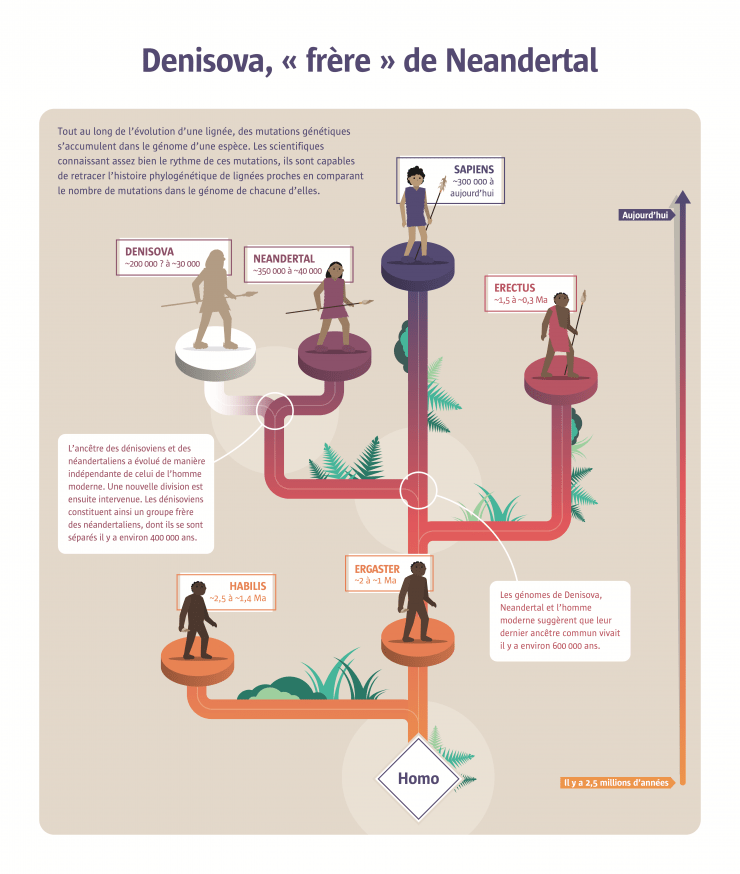
Challenges related to ancient DNA
The extraction of fossil DNA is rarely possible and relies on special conditions … like those in the Denisova Cave.
If DNA is to be of use in palaeontology, it must have been protected from environmental, biological and physical damage, especially deterioration caused by excessively high temperatures. It is better conserved in calcified tissue, such as bones, teeth or keratin, where bacterial spoilage is low. In humans, the precious compound is best preserved in the periotic bone of the inner ear, which is not very vascular. But even in optimal conditions, ultimately, DNA breaks down, fragments and deteriorates, and it grows harder and harder to extract information from it. But if available strands are still long enough, it is possible to sequence the genome by reconstructing the structure of the nucleotides—the basic components of DNA and RNA (represented by the letters A, C, G, T and U). And when the biological tissue has not been fossilised, it is now possible to apply another emergent technique: the extraction of DNA conserved in sediments. Contrary to the analysis of bone DNA, which requires the crushing of a small part of the fossil, that method is not destructive. In 2017 and then 2021, work led by German researchers identified Denisovan DNA in sediment samples collected in the Altai cave.
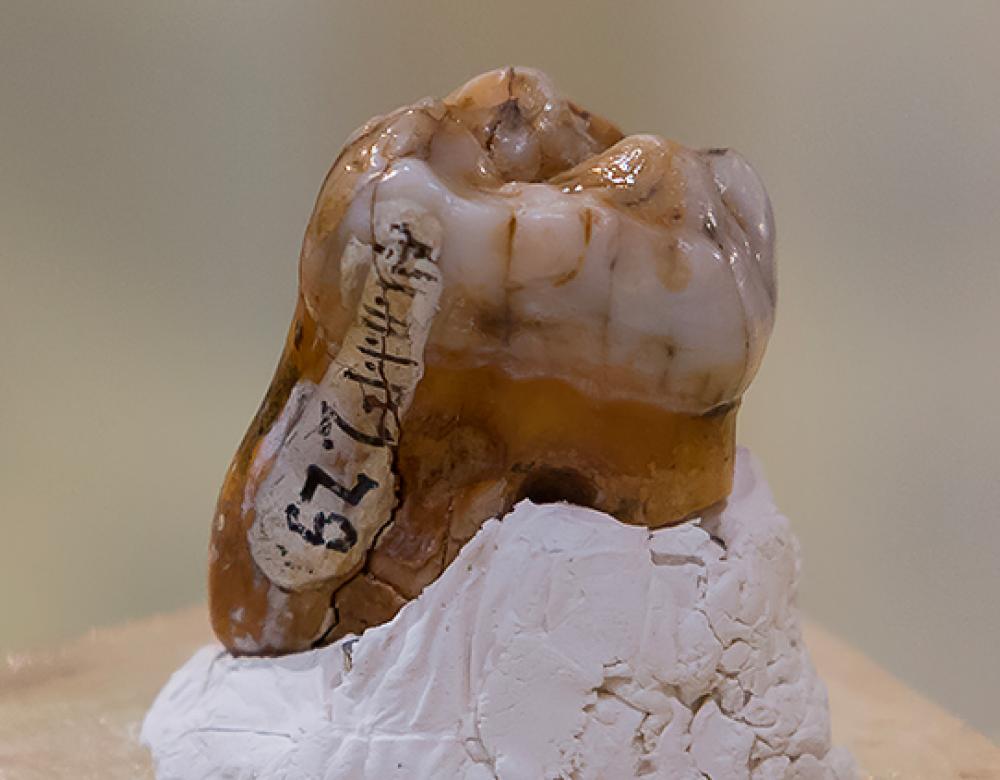
Rare bone remnants
Three molars and a fragment of phalanx led to the identification of Denisovans in 2010. Very few other remnants of the hominins have been found to date. In 2021, analysis of 3,800 fossils found in the Siberian cave enabled the identification of three new specimens. They did not contain DNA, but did hold specific proteins. In 2022, another molar discovered in Southern Laos late in 2018 was attributed to a little Denisovan girl. Those small fossils have supplied a certain amount of morphological information. Denisovan teeth were larger than those of Homo sapiens and Neanderthals, while their phalanxes were more like those of modern humans. But with no large fossils discovered so far, it remains difficult to paint a better picture of Denisovans.
Denny, the first known hybrid
Ancient DNA conserved in a 2.5-centimetre-long bone fragment tells a story worthy of Shakespeare.
Discovered in the Denisova cave in 2012 and dating back around 90,000 years, the bone fragment has a thin wall, suggesting that it belonged to a girl who died aged about 13. The sequencing of her genome shows that only half of her chromosomal DNA is Denisovan. The other half is Neanderthal, as is all the mitochondrial DNA she inherited from her mother. So the girl—who has been named Denny—was a first-generation hybrid born to a Neanderthal mother and Denisovan father. More detailed analysis of her genome has partly revealed her parents’ background. Her mother was more closely related to Neanderthals found in the Vindija cave in Croatia nearly 5,000 km away than those found next to Denny in the Denisova cave. As for her father, he had had at least one Neanderthal ancestor a few hundred generations previously. So Denny’s genome alone offers evidence of multiple interactions between Neanderthals in West Eurasia and Denisovans in the East. Even though the two archaic populations would not have met often, they probably interbred during interglacial periods when more moderate climatic conditions enabled Neanderthals to travel east to the Altai Mountains.
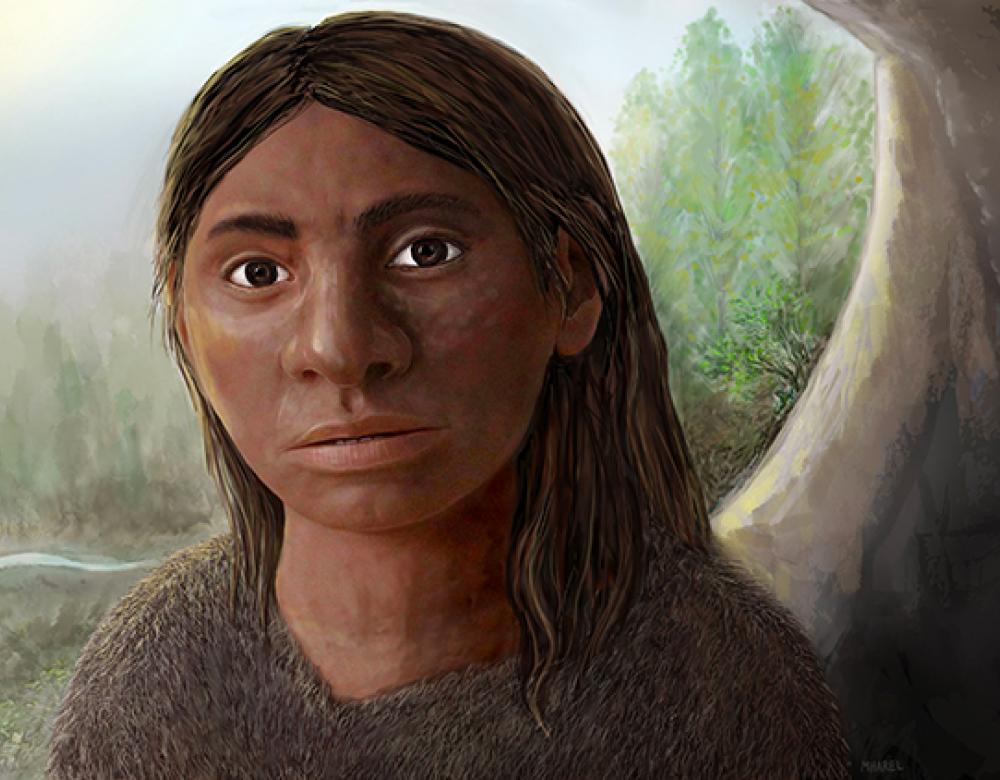
What about Denisovan faces?
What did Denisovans look like? Their genome allows certain physical traits to be identified, such as eye colour which is coded by genes found in modern humans. However, other characteristics are harder to establish. In 2019, researchers suggested reconstructing Denisovan morphology by studying chemical markers set on their DNA in the course of evolution, which the team associated with anatomical attributes. Not all the scientific community felt the approach was valid, but the results suggested that Denisovans had broad pelvises and a prominent jaw like that of the Neanderthals, but a wider skull.
Natural selection at work
Like the Neanderthals’, the Denisovan genome shows signs of an adaptation which benefited modern humans.
During successive acts of interbreeding with archaic populations, natural selection certainly preserved genes that gave the ancestors of modern humans survival advantages. For instance, Tibetans living on the high plateaux of the Himalayas are acclimatized to the conditions there and need less oxygen because they have a version of a gene appropriate to populations living at a high altitude. Copies of that gene—which is very similar to one present in the Denisovan genome—are virtually absent in the Han Chinese, who live in the same region but at a lower altitude. In other words, interbreeding between Denisovans and Homo sapiens certainly led to the incorporation of that fragment of archaic DNA in the genome of the local ancestors of modern humans. That “introgression”—the transfer of genes from one species to another—would have occurred before the separation of the Han and Tibetan groups about 20,000 years ago. When the Tibetans began to populate the high plateaux, the copy of the gene was passed on down the generations through natural selection. Another example: research suggests selection among Papuans for Denisovan genes favouring a metabolism adapted to a plant diet. This hypothesis ties in with archaeological evidence of their consumption of plant resources 49,000 years ago and then the development of horticulture in Papua New Guinea 9,000 years ago.
Population interbreeding
The Ayta Magbukon of the Philippines have the highest share of genes inherited from the Denisovans. That is the conclusion of research published in 2021, for which around fifty scientists analysed nearly 2.3 million genes from 118 local ethnic groups. In Southeast Asia, other populations (Indonesian, Australian and Papuan) still show signs of interbreeding with several lines of Denisovans. Their varying proportions of archaic DNA suggest that the Homo sapiens who left Africa to populate the region initially interbred with Denisovans, but then with other Homo sapiens who arrived later.
From genetics to biology
DNA can provide us with information on the biology, demographics and epidemiology of archaic peoples.
In 2021, French researchers studied genes coding for blood groups—the proteins on the surface of red blood cells—from three Neanderthals and a Denisovan. That basic data revealed brand-new information. Firstly, the presence of genetic mutations found in modern humans in sub-Saharan Africa, corroborating the African origin of both Denisovans and Neanderthals. Contrary to the conclusions of previous studies, research also confirmed that the ABO blood-group system of modern humans was already present in those archaic peoples: two Neanderthals were group A+ partial and one was group B+ partial, while the Denisovans were group O+ complete. The research also showed that Neanderthal populations had low genetic diversity. Although they lived far apart, their rhesus was identical. The rhesus positive partial notably confirmed the risk of incompatibility when they interbred with Denisovans who were fully rhesus positive. If the mother and father’s rhesus were not the same, there was an increased chance of miscarriage. Another finding was that the four archaic genomes had a copy of the gene that prevents the ABO system blood groups from being expressed anywhere other than on the surface of red blood cells. Today, we know that gene confers an advantage in dealing with certain gastroenteritis viruses, noroviruses, suggesting that those populations may already have been exposed to the pathogen.
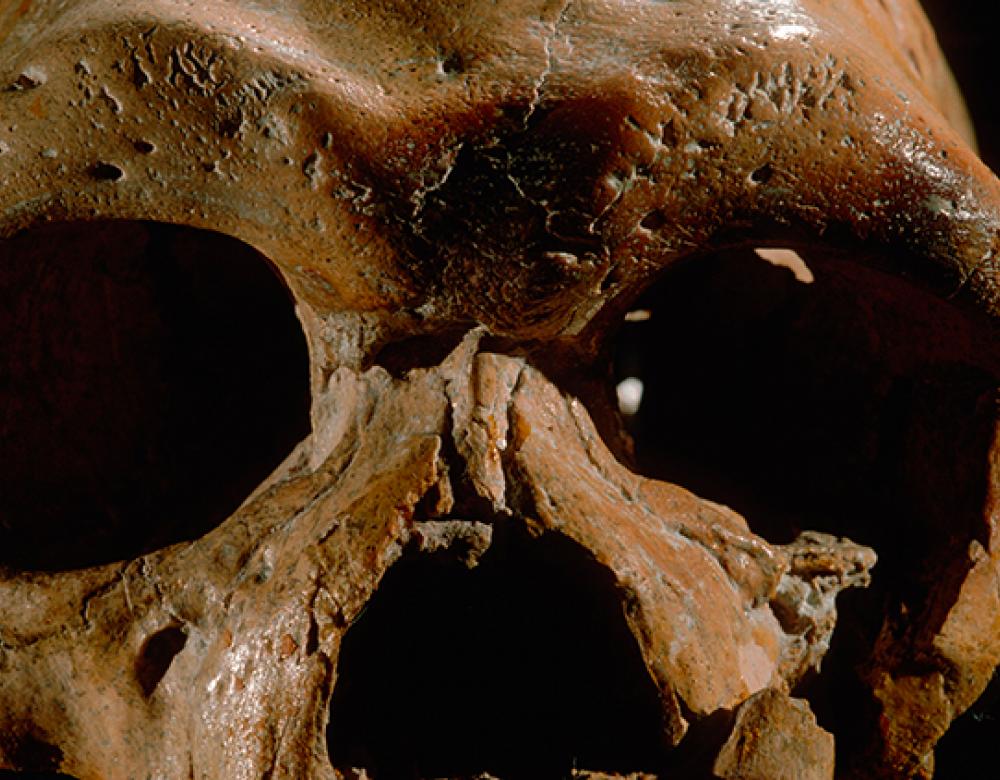
Hidden treasure in reserve collections?
What if there were undiscovered Denisovan remains in our museums’ reserve collections? To answer that question, scientists are currently investigating the origin of a number of well-preserved Chinese fossils: a human skull found in Shaanxi in 1978 (photo), another unearthed in a cave in Guangdong province in 1958, and one dug up in Harbin, Northern China, in 1933. They could come from a line of Neanderthals of Chinese origin, a local evolutionary branch of Homo erectus or… Denisovans. If that last hypothesis were confirmed, it would throw light on the appearance of those hominins.
Promising palaeoproteomics
Denisova lived in the tropics. That is the conclusion of a paper published in May 2022 by a scientific team led by French researchers. Based on the analysis of ancient proteins, it effectively concluded that a molar 160,000 to 130,000 years old discovered in 2018 in Laos belonged to a little Denisovan girl. The composition of proteins encoded in the genome enables the identification of family relationships between individuals. The method used is known as “palaeoproteomics”. While DNA deteriorates over time, fossil proteins last ten times longer on average, so can sometimes provide information about the past.
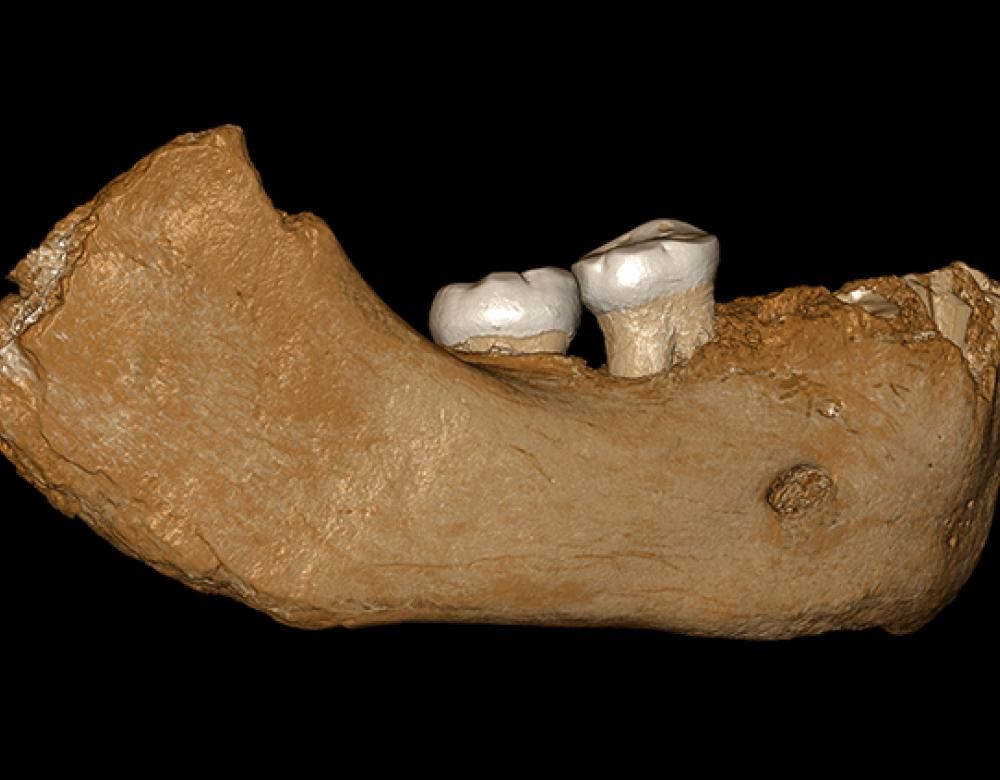
A new view of the past
Denisovans were discovered using DNA alone and that has changed the way we study human history.
The development of palaeogenetics opens the way for joint research by palaeontologists, archaeologists and geneticists. Thanks to technological progress that has led to cheaper sequencing, scientists can now compile a great library of ancient DNA. So the “Denisova Affair” could be repeated. Indeed, in modern human DNA, unidentified genome sections could have been inherited from other archaic populations yet to be discovered. And genomes provide information about genetic diversity and family relationships—like those of the hybrid with a Neanderthal mother and Denisovan father—and the level of consanguinity within a group. Also, the sequencing of ancient bacterial or viral DNA could tell us more about how healthy the living conditions of archaic populations were. So the sequencing of a gastroenteritis virus could explain why a gene for resistance to that virus was found in a Denisovan genome. Finally, if archaeologists can successfully track the geographic spread of a Denisovan cultural trait (such as the production of useful or art objects), geneticists could study the spread of genes over the same period to find out whether the Denisovan population migrated with its culture, or if the spread results from acculturation. The emergence of palaeogenetics seems to herald many new ways of exploring the past!
